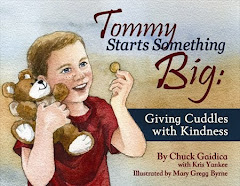So, I missed last week's Thursday post about The Hook. Life was way busier than I anticipated.
This Thursday, I'll talk about hook and POV - point of view for you non-writers out there.
Until then, stay warm and snuggle up with a good book.
Monday, January 24, 2011
Thursday, January 13, 2011
Writing Workshop Session 1 - Children's Picture and Chapter Books
So tonight is the first of a five-week writing workshop that I put on for the press that I work for during the day. Here is a run down of what I'll be discussing:
So, how do you take a concept and make it into a story?
We all have great story ideas, but it's hard to actually turn those ideas into a storyline that is engaging to readers. But there are good ideas and bad ideas. An example of a bad idea would be the following story:
There was a little girl who wished that there would be snow on Christmas.
She wished and wished, but still there was no snow.
She went to bed on Christmas Eve and asked Santa to bring snow.
When she woke up, there was snow.
Okay, so that's pretty lame. You can say it; it won't hurt my feelings.
What's lacking in the above story is a believable story problem. Sure, a little girl wants snow and she thinks that by asking Santa for snow, she'll get snow.
But is it really engaging? No.
Is it believable? Nope.
Do we have all of the mechanics of a story - story problem, beginning, middle, end, dialogue, action, point of view? No, no, no, and a big fat NO!
We can all agree that the above four lines are not a story in the publishing world.
Could we make the above into a story? Sure. I guess. But we're going to need a beginning, middle, and an end. Most of all, we need a central problem or question and believable characters.
What is a story question/problem?
This is the whole meat of the story. Here are some examples from some of the most recent NPM books:
Oh, you're back. What did you find? Were you able to figure out the story question?
Here are what I think the story question is for a two books I've read recently:
Hunger Games: Will Katniss, and her family, survive?
The Graveyard Book: Will Bod find out who killed his family and leave the cemetery?
Obviously, these are very simplistic story questions (what I wrote out above, not what the author used to create the story), and both books actually have more themes/concepts running through them. But in simple terms, these are pretty much the heart of each story.
When you come up with a story idea, take the time to figure out what will be the obstacles that the MC will need to overcome. By doing this, you'll automatically begin to develop your story question.
Another topic that goes along with story question/problem is audience. Who do you see reading your book? That person/reader is your audience. With the audience in mind, the writer needs to be aware of word choice, character development, setting, and their story problem. If you're writing a picture book and the main character is eight, the dialogue should match an eight-year-old (unless another character is speaking.) The eight-year-old MC wouldn't be smoking, dangling from an open window on a high rise, or driving a car in a high speed chase. Also, the MC wouldn't be telling people they have "tenacity" or that they'd "prefer to eat liver and onions with capers".
Your audience needs to be able to identify with your MC. They need to be wanting the MC to win the race, make the team, or be accepted by a new friend --> whatever the story problem.
With knowing who your audience is, the writer will be able to create more believable characters who will then be highly identifiable with the reader. See the circle?
Although the writing workshops tend to lean toward writing for children, the same concepts are used in writing for adults.
Next time I'll talk about The Hook.
- How do you take a concept and make it into a story?
- Who is your audience, and how do you determine?
- Creating a story problem and characters
- Beginning, middle, and end
- The all important Hook
- Working with the story problem/plot
- How do you develop believable characters
So, how do you take a concept and make it into a story?
We all have great story ideas, but it's hard to actually turn those ideas into a storyline that is engaging to readers. But there are good ideas and bad ideas. An example of a bad idea would be the following story:
There was a little girl who wished that there would be snow on Christmas.
She wished and wished, but still there was no snow.
She went to bed on Christmas Eve and asked Santa to bring snow.
When she woke up, there was snow.
Okay, so that's pretty lame. You can say it; it won't hurt my feelings.
What's lacking in the above story is a believable story problem. Sure, a little girl wants snow and she thinks that by asking Santa for snow, she'll get snow.
But is it really engaging? No.
Is it believable? Nope.
Do we have all of the mechanics of a story - story problem, beginning, middle, end, dialogue, action, point of view? No, no, no, and a big fat NO!
We can all agree that the above four lines are not a story in the publishing world.
Could we make the above into a story? Sure. I guess. But we're going to need a beginning, middle, and an end. Most of all, we need a central problem or question and believable characters.
What is a story question/problem?
This is the whole meat of the story. Here are some examples from some of the most recent NPM books:
- Will a new student at school be able to shed his bullying-type behavior and adopt The Promise?
- Will a new addition to a family be able to learn about bucketfilling and bucketdipping?
- Does a person's clothes/accessories represent their true identity?
Oh, you're back. What did you find? Were you able to figure out the story question?
Here are what I think the story question is for a two books I've read recently:
Hunger Games: Will Katniss, and her family, survive?
The Graveyard Book: Will Bod find out who killed his family and leave the cemetery?
Obviously, these are very simplistic story questions (what I wrote out above, not what the author used to create the story), and both books actually have more themes/concepts running through them. But in simple terms, these are pretty much the heart of each story.
When you come up with a story idea, take the time to figure out what will be the obstacles that the MC will need to overcome. By doing this, you'll automatically begin to develop your story question.
Another topic that goes along with story question/problem is audience. Who do you see reading your book? That person/reader is your audience. With the audience in mind, the writer needs to be aware of word choice, character development, setting, and their story problem. If you're writing a picture book and the main character is eight, the dialogue should match an eight-year-old (unless another character is speaking.) The eight-year-old MC wouldn't be smoking, dangling from an open window on a high rise, or driving a car in a high speed chase. Also, the MC wouldn't be telling people they have "tenacity" or that they'd "prefer to eat liver and onions with capers".
Your audience needs to be able to identify with your MC. They need to be wanting the MC to win the race, make the team, or be accepted by a new friend --> whatever the story problem.
With knowing who your audience is, the writer will be able to create more believable characters who will then be highly identifiable with the reader. See the circle?
Although the writing workshops tend to lean toward writing for children, the same concepts are used in writing for adults.
Next time I'll talk about The Hook.
Wednesday, January 12, 2011
Writing Workshop warm-up
Tomorrow evening I'll begin a five-week writing workshop at the publishing house where I work. I haven't done one of these in at least six months - maybe even longer. I truly can't remember.
In honor of that - or at least in order to get me warmed up - stop back here every Thursday for the next five weeks to learn what I'll be speaking about during the workshop. I'll post the homework that I'll be giving out as well as answering any questions you readers may have.
It should be fun, so be sure to stop by.
In honor of that - or at least in order to get me warmed up - stop back here every Thursday for the next five weeks to learn what I'll be speaking about during the workshop. I'll post the homework that I'll be giving out as well as answering any questions you readers may have.
It should be fun, so be sure to stop by.
Monday, January 10, 2011
Picture Book NOW Available
Tommy Starts Something Big: Giving Cuddles with Kindness is now available. You can purchase at Chuck Gaidica's website or at Amazon.
Wednesday, January 5, 2011
New Project, New Playlist
First of all, Happy New Year!
I hope you said good-bye to 2010 painlessly and have welcomed the new year with expectations and dreams.
I've started a new project while TK is being shopped around. With a new project comes a new playlist.
This story is more emotional and bit darker than TK, so the music is way different.
What do you think?
F**kin' Perfect by P!nk
Not Afraid by Eminem
Raise Your Glass by P!nk
Gives You Hell by The All-American Rejects
Love the Way You Lie by Eminem
In the End by Linkin Park
Wonderful by Gary Go
Hey Jealousy by Gin Blossoms
Airplanes by B.O.B.
New Divide by Linkin Park
If I Never See Your Face Again by Maroon 5
Life is a Highway by Tom Cochrane
Let it Rock by Kevin Rudolf & Lil Wayne
Move Along by The All-American Rejects
Family Portrait by P!nk
Love Like Woe by The Ready Set
Give a Little More by Maroon 5
World on Fire by Sarah McLachlan
Landslide by Dixie Chicks
She Will Be Loved by Maroon 5
For You I Will - Confidence by Teddy Geiger
Building a Mystery by Sarah McLachlan
High by James Blunt
Everything by Alanis Morissette
The Remedy by Jason Mraz
Shadow of the Day by Linkin Park
You and Me by Dave Matthews Band
You and Me by Sarah McLachlan
Boulevard of Broken Dreams by Green Day
And there are about 10 more! I can't believe how big of a playlist I made for this one. But if you look at the songs, you may be able to figure out the underlying issues of this story.
Can you figure it out?
I hope you said good-bye to 2010 painlessly and have welcomed the new year with expectations and dreams.
I've started a new project while TK is being shopped around. With a new project comes a new playlist.
This story is more emotional and bit darker than TK, so the music is way different.
What do you think?
F**kin' Perfect by P!nk
Not Afraid by Eminem
Raise Your Glass by P!nk
Gives You Hell by The All-American Rejects
Love the Way You Lie by Eminem
In the End by Linkin Park
Wonderful by Gary Go
Hey Jealousy by Gin Blossoms
Airplanes by B.O.B.
New Divide by Linkin Park
If I Never See Your Face Again by Maroon 5
Life is a Highway by Tom Cochrane
Let it Rock by Kevin Rudolf & Lil Wayne
Move Along by The All-American Rejects
Family Portrait by P!nk
Love Like Woe by The Ready Set
Give a Little More by Maroon 5
World on Fire by Sarah McLachlan
Landslide by Dixie Chicks
She Will Be Loved by Maroon 5
For You I Will - Confidence by Teddy Geiger
Building a Mystery by Sarah McLachlan
High by James Blunt
Everything by Alanis Morissette
The Remedy by Jason Mraz
Shadow of the Day by Linkin Park
You and Me by Dave Matthews Band
You and Me by Sarah McLachlan
Boulevard of Broken Dreams by Green Day
And there are about 10 more! I can't believe how big of a playlist I made for this one. But if you look at the songs, you may be able to figure out the underlying issues of this story.
Can you figure it out?
Subscribe to:
Posts (Atom)










